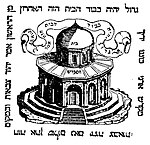Printer's mark

A printer's mark, device, emblem or insignia was a symbol used as a trademark by early printers starting in the 15th century.
The first printer's mark is found in the 1457 Mainz Psalter by Johann Fust and Peter Schöffer.[1] One of the most well-known old printer's marks is the dolphin and anchor, first used by the Venetian printer Aldus Manutius as his mark in 1502.[2]
The database Printers' Devices of the Ancient Book Section of the Library of the University of Barcelona, was launched in October 1998.[3] The University of Florida libraries also provide digital access to printers' devices and include The University of Chicago devices that have appeared on the cover of their publication The Library Quarterly. [4]

Printers' devices have been incorporated in American library buildings, as a reflection of the British Arts and Crafts Movement. [5]
See also
References
- ^ Roberts, William (1893). Printers' Marks, by. London: George Bell & Sons, York Street, Covent Garden, & New York.
- ^ Nicole Howard, "Printer's Devices", The book: the life story of a technology
- ^ University of Barcelona. "Printer's Devices" http://www.bib.ub.edu/fileadmin/impressors/home_eng.htm
- ^ University of Florida, George A. Smathers Libraries http://web.uflib.ufl.edu/spec/rarebook/devices/device.htm
- ^ Karen Nipps, "Printers' Devices as Decorative Elements in Library Architecture." The Library Quarterly 83 (July 2013): 271-278.
External links
- Roberts, W. (1893). Printer's marks: a chapter in the history of typography. London; New York: George Bell & Sons. Project Gutenberg Ebook #25663 Released Jun 1, 2008.
- Printers' marks from digitized rare books at the Linda Hall Library
- Base de Typographie de la Renaissance, a database of circa 1100 marks and thousands of other printed ornaments
- Signa vides. Researching and recording printers‘ devices. Papers presented on 17-18 March 2015 at the CERL Workshop, hosted by the National Library of Austria, Vienna, ed. by M. Scheibe / A. Wolkenhauer, London 2015 (CERL Studies) [1]
- Typographorum emblemata. The Printer’s Mark in the Context of Early Modern Culture, ed by Anja Wolkenhauer and Bernhard F. Scholz, Walter de Gruyter, Berlin/ NY 2018 (Schriftmedien 4) ISBN 978-3-11-043919-9, an international handbook and bibliography.

